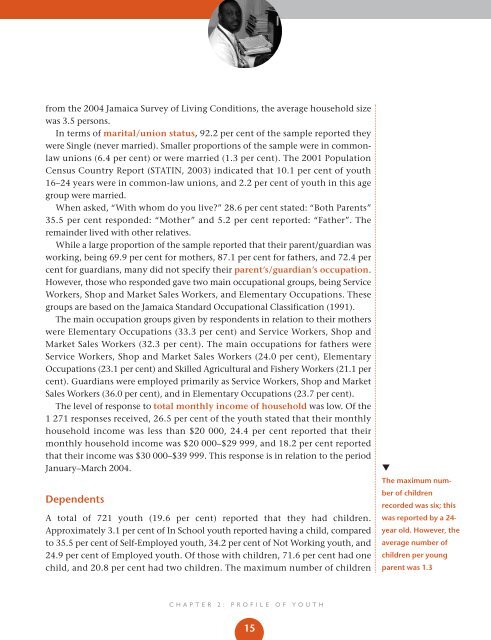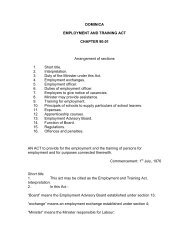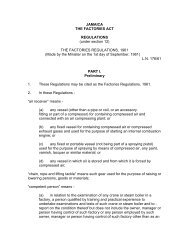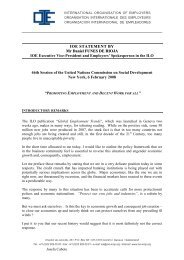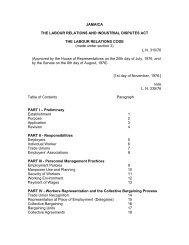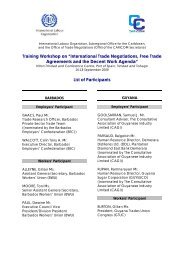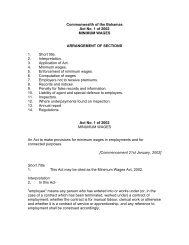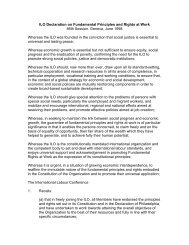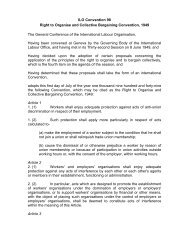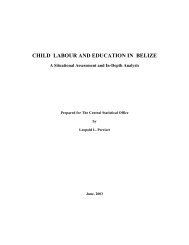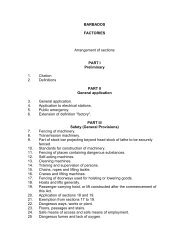The Transition of Jamaican - International Labour Organisation ...
The Transition of Jamaican - International Labour Organisation ...
The Transition of Jamaican - International Labour Organisation ...
Create successful ePaper yourself
Turn your PDF publications into a flip-book with our unique Google optimized e-Paper software.
from the 2004 Jamaica Survey <strong>of</strong> Living Conditions, the average household size<br />
was 3.5 persons.<br />
In terms <strong>of</strong> marital/union status, 92.2 per cent <strong>of</strong> the sample reported they<br />
were Single (never married). Smaller proportions <strong>of</strong> the sample were in commonlaw<br />
unions (6.4 per cent) or were married (1.3 per cent). <strong>The</strong> 2001 Population<br />
Census Country Report (STATIN, 2003) indicated that 10.1 per cent <strong>of</strong> youth<br />
16–24 years were in common-law unions, and 2.2 per cent <strong>of</strong> youth in this age<br />
group were married.<br />
When asked, “With whom do you live?” 28.6 per cent stated: “Both Parents”<br />
35.5 per cent responded: “Mother” and 5.2 per cent reported: “Father”. <strong>The</strong><br />
remainder lived with other relatives.<br />
While a large proportion <strong>of</strong> the sample reported that their parent/guardian was<br />
working, being 69.9 per cent for mothers, 87.1 per cent for fathers, and 72.4 per<br />
cent for guardians, many did not specify their parent’s/guardian’s occupation.<br />
However, those who responded gave two main occupational groups, being Service<br />
Workers, Shop and Market Sales Workers, and Elementary Occupations. <strong>The</strong>se<br />
groups are based on the Jamaica Standard Occupational Classification (1991).<br />
<strong>The</strong> main occupation groups given by respondents in relation to their mothers<br />
were Elementary Occupations (33.3 per cent) and Service Workers, Shop and<br />
Market Sales Workers (32.3 per cent). <strong>The</strong> main occupations for fathers were<br />
Service Workers, Shop and Market Sales Workers (24.0 per cent), Elementary<br />
Occupations (23.1 per cent) and Skilled Agricultural and Fishery Workers (21.1 per<br />
cent). Guardians were employed primarily as Service Workers, Shop and Market<br />
Sales Workers (36.0 per cent), and in Elementary Occupations (23.7 per cent).<br />
<strong>The</strong> level <strong>of</strong> response to total monthly income <strong>of</strong> household was low. Of the<br />
1 271 responses received, 26.5 per cent <strong>of</strong> the youth stated that their monthly<br />
household income was less than $20 000, 24.4 per cent reported that their<br />
monthly household income was $20 000–$29 999, and 18.2 per cent reported<br />
that their income was $30 000–$39 999. This response is in relation to the period<br />
January–March 2004.<br />
Dependents<br />
A total <strong>of</strong> 721 youth (19.6 per cent) reported that they had children.<br />
Approximately 3.1 per cent <strong>of</strong> In School youth reported having a child, compared<br />
to 35.5 per cent <strong>of</strong> Self-Employed youth, 34.2 per cent <strong>of</strong> Not Working youth, and<br />
24.9 per cent <strong>of</strong> Employed youth. Of those with children, 71.6 per cent had one<br />
child, and 20.8 per cent had two children. <strong>The</strong> maximum number <strong>of</strong> children<br />
<br />
<strong>The</strong> maximum number<br />
<strong>of</strong> children<br />
recorded was six; this<br />
was reported by a 24-<br />
year old. However, the<br />
average number <strong>of</strong><br />
children per young<br />
parent was 1.3<br />
CHAPTER 2: PROFILE OF YOUTH<br />
15


